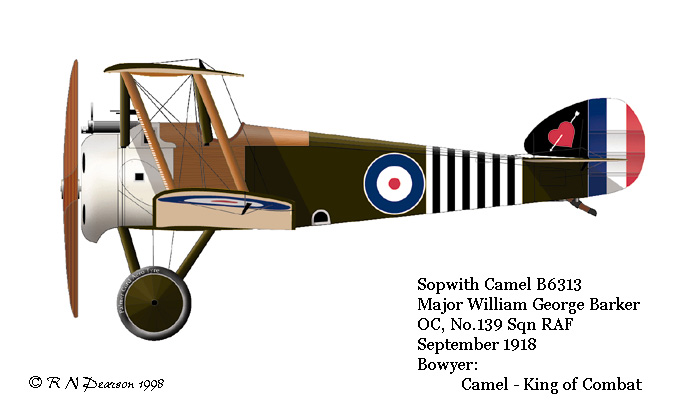The Sopwith F.1 Camel:
Historical Notes:
The Camel was tail heavy, making it difficult and tiring to fly. The pilot had to keep his focus on the controls at all times, but once used to it such became second nature. If the pilot was not dead by this point, his abilities with the Camel made him a deadly opponent. The Camel had several quirks which were nearly impossible to simulate in the CFS system. One was its uncanny ability to do a 3/4 right turn as fast as a 1/4 left turn. This was caused largely by the immense torque created by the Clerget engine. Though slower than most other machines, the Camel was a fine aerobatic mount, and there are numerous combat actions where Camels came out the victor against superior odds.
The Camel's construction made it sufficiently strong enough to handle violent maneuvers, except for steep power dives. Maneuverability was enhanced by ailerons on both wings, not only with separate cables for each, but linking cables between the two wings. Thus, if one cable was shot out, the machine's maneuverability was only marginally effected. The other factor to the Camel's success was in its armament. It was the first British aircraft to mount twin Vickers machineguns on the cowling, giving it the superior firepower it needed to match the German machines in the air. Coupled this with its eccentric maneuverability and the Camel became a deadly adversary.
Camels arrived on the Western Front in July of 1917, and were later deployed to other theaters. Its service was short lived, as it was quickly replaced by the Sopwith Snipe at the close of the war. By October of 1918, over 4,500 Camels were in operation on all fronts.
Camels were a "love it or hate it" type machine. As Captain Norman MacMillian put it: "The Camel was a fierce little beast...."
Basic performance statistics: Camel F.1 (trial report M.86B)
Engine: Clerget 130 hp
Weight: empty 1,460
Maximum speed: 115 mph at 6,500 feet
Climb rate: to 10,000 feet.... 10 min, 50 sec.
Service ceiling: 22,000 feet
Flight endurance: 2.5 hours
Basic Specifications (vary from model to model):
Manufacturer: Sopwith Aviation Company, Ltd. (also sub-contracted to others)
Dimensions: Span 28 ft; Length 18 ft, 6 in; Height: 8ft, 6 in; Stagger: 18 in; Dihedral: upper none, lower 5 deg.; Incidence: 2 deg.; Span of tail: 8 ft, 2.5 in.
Areas: Wings 232 sq ft; Rudder 4.9 sq ft
Fuel: Main tank 30 gallons; gravity tank 7 gallons; oil 6.5 gallons
Armament: twin Vickers machineguns synchronized to fire through the airscrew; four 25lb bombs
Typical ammo load: 400 rounds per gun
Primary sources: "Jane's Fighting Aircraft of World War I, 1919 (1990 reprint); "British Aeroplanes, 1914-1918," J.M. Bruce; "German Aircraft of the First World War," Gray and Thetford; "German Air Power in World War I," Morrow; "Fighter Aircraft of the 1914-1918 War," Lamberton, et al; "Aircraft Camouflage and Markings 1907-1954," Robertson et al; "Military Small Arms of the 20th Century," Hogg and Weeks.
Fighting and winning in the Camel F1:
A quick note about climb rates and speed. The CFS system frustrated my attempts to make accurate climb rates for the planes. Most (but not all) CFS type planes climb faster than they should. Climb rates for this machine (and other WW 1 types) are adjusted on a ratio where the rate is 12 to 15% faster than historically accurate. Although the planes climb faster, the adjustments made them climb accurately in comparison to each other. This was crucial, since climbing (and diving) were principle tactics in aerial combat, placing a pilot either in control, or at the mercy of his foes. Regarding speed, it has been noted that planes tend to fly faster on the internet (WW I machines going 15-18 mph faster). Thus, the AIR file was adjusted to slow the plane down. You will see this if you fly the plane against the computer in Quick Combat.
The Camel can out turn nearly every WW I plane (and even many WW 2 ones) in existence. The only German aircraft which can hold its own are the Fokker Dr 1 Triplane and the Fokker DVIII Monoplane. The Camel will even turn inside on the Fokker DVII. However, do not try and out power the DVII, as it can climb just as fast, dive steeper and faster, and can tail stand ("hang on its prop"). Older Albatros and Pfalz planes are "meat on the table." However, if you go in too cocky, you could get caught napping and get flamed. The Camel is durable, but not like the Fokker DVII or Pfalz DIII. Work in pairs (team games), with another Camel pilot who understands the machine. And stay together. Once in a dogfight, it is difficult for you to disengage, since the Camel's speed is inferior to that of many German machines, and you will need backup. A skilled flier with a Pfalz DIII can take you out quickly if you don't pay attention. And this is even more imperative if you're facing Fokker DVIIs.
If you fly on the Zone alone, pick and choose your fights. Many guys on the Zone simply dive in and fight. It can be a lot of fun, but if you want to try simulating the real thing, hang out and pick your fight carefully. Dive in, turn on your opponent, flame him and then pull out. If followed, use the quick turns of the Camel to turn on your opponent until he's yours. If you follow an enemy too long, somebody else will jump your tail and take you out. For the hard-core simmer, it is much more accurate to flame only one, maybe two planes in a session, and come out alive, then to shoot down 15, but get flamed 12.
